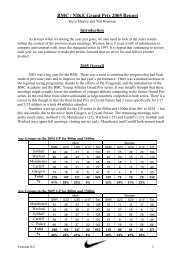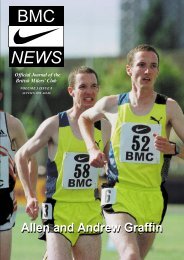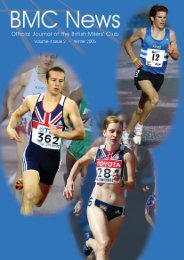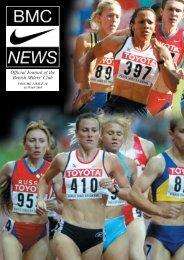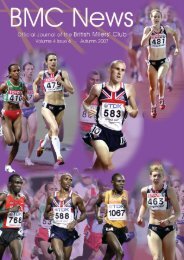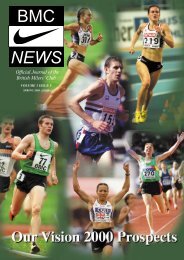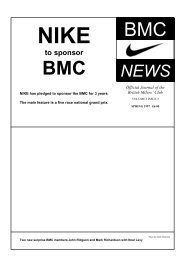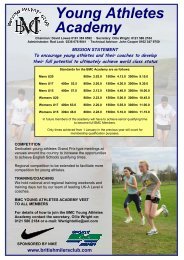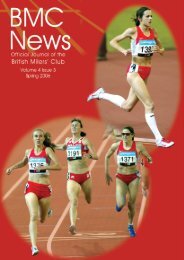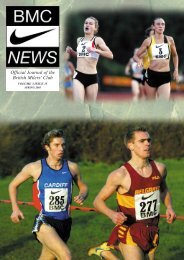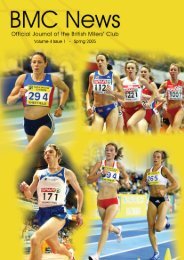You also want an ePaper? Increase the reach of your titles
YUMPU automatically turns print PDFs into web optimized ePapers that Google loves.
BMC April <strong>1999</strong> 6/6/99 9:07 pm Page 24The Evolution of the Women’s 800 Metresby Frank HorwillThe first unofficial world record for the women's800 metres was established in Sweden in 1914.Elsa Sundberg ran 3:04.9. This time, a year later,was shattered by another Swede, Elsa Dahl, whorecorded 2:50.8. In the first ever Women'sInternational Games held in 1921 in MonteCarlo, Lucie Breard of France, caused a majorsensation by covering the distance in 2:30.2. Herachievement was short lived - ten days later MaryLines of Great Britain ran 2:26.6, and also 440yds in 62.4. Both times made the I.A.A.F. firstofficial record list. In 1925 Edith Trickey notonly lowered the record to 2:24.0, but ran 3:08.8for the unheard of distance of one kilometre.At last, women were permitted to run the 800metres for the first time in the AmsterdamOlympic Games of 1928. However, from thesublime to the ridiculous. The organisers heldheats, semi-finals and final, on consecutive days.Some of the finalists had taken part in otherevents beforehand and were clearly tired. Thefinal was an epic battle between Radke-Batschauer of Germany, and Kinue Hitomi ofJapan. The German woman won in 2:l6.8.Hitomi ran 2:l7.6. Half of the field collapsed onthe line and this led to a protest to the I.O.C. andthe I.A.A.F. for the event to be ousted fromfuture Games. Meanwhile, women's athleticsgoverning bodies were defiant, and they includedthe two lap event in all major meetings. At oneof these Gladys Lunn of England ran 2:18.2 forthe half-mile, which converted well to the metrictime of the German woman.As the Second Great War drew near, two 800metre pioneers came to the fore. ZdenkaKoubkova (Czechoslovakia) ran a world recordof 2:12.4. However, there were some doubts asto her sexuality. Yevdokiya Vasilyeva (USSR),became the first Russian woman to break 2:20,and later ran 2:15.3. In 1940 the U.S.S.R. had allthe first ten places in the World List.Very little is known about the training methodspractised by the world record breakers listed.But, two important findings occurred during thisperiod, which influenced the training of both menand women. The first of these occurred in 1932,when Nobel Prize winning A.V. Hill publishedhis now famous aerobic/anaerobic table. Hestated that the 800 metres event was two thirdsanaerobic and one third aerobic. The racerequired a total of 27 litres of oxygen, the athletecould only breathe in a total of 9 litres. Thisinformation was largely ignored or misunderstoodfor many years until Professor Nocker(Germany) stated that it told the athlete preciselyhow to train. Given six training sessions in aweek, four (two thirds) would be anaerobic.Again, there was a controversy as to what theseterms actually meant in practical sessions. Theanswer was to be found in HillÕs original table.He listed the following as predominantlyanaerobic:- 200 metres maximum speed Ð 95 %anaerobic. 400 metres maximum speed Ð 83 %.800 metres maximum speed Ð 67 %. 1500metres at maximum speed 50 %. The followingare predominantly aerobic:- Marathon pace Ð 99% aerobic. Half marathon pace Ð 94 %. 10k paceÐ 90 %. 5k pace Ð 80 %. 3k pace Ð 60 %.Hill, in 1932, stated that the 800 metreswas two thirds anaerobic and one thirdaerobicAlthough the marathon pace might be 7:00/mile,the half marathon speed will be about 6:45/mile,the 10k speed about 6:30/mile, the 5k speedaround 6:15/mile, 3k speed about 6:00/mile andthe 1500m speed 5:45/mile. The longer distancesmay be called Ôslow aerobicÕ, while the shorterdistances can be called Ôfast aerobicÕ.The second advance occurred after the secondGreat War when attention was focused on Dr.Woldemar GerschlerÕs interval training method.GerschlerÕs athlete, Rudolph Harbig, held the800 metres world record with 1:46.6 and held itfor 16 years. Gerschler stated that steadyrunning was "wasteful and inefficient". Heclaimed that in 6 weeks of his interval training, arunner would be fitter than one who ran steadyfor an hour a day for 12 weeks! He selectedthree distances Ð 100, 200 and 600 metres. Theywere to be run 3, 6 and 18 seconds slowerrespectively than for oneÕs best times for thedistances. If an athlete has a best of 28 secondsfor the 200 metres, the 200 metres is run in 34seconds. After each run, the recovery is the timeit takes the pulse to return to 120 beats a minute(20 beats in 10 seconds), provided it did notexceed 90 seconds to do so. If it did, the sessionstops. He claimed that the training effectoccurred during the recovery time! How canthat be? ItÕs all to do with the stroke volume ofthe heart, the amount of blood pumped out byone beat per minute. During a run the pulse mayrise to 180 bpm and the stroke volume may be 90mls a beat. But during the recovery period, thepulse rate will rapidly decline but the strokevolume may rise to as much as 110 mls a beat. Itis this, that Greschler asserted, strengthened theheart muscle. Interval training had arrived and isnow often referred to as repetition running. Oneof the first successful <strong>British</strong> females to use itwas Diane Leather. Born in 1933, she was 5 feet9 1 /2 inches tall, weighing 130 lbs, and recorded2:09.6/800m, 56.3/400m 26.8/220 yards,12.0/100m. But she was better known for beingthe first <strong>British</strong> woman to break 5 minutes for themile, her best being 4:45. Some of her routinesare quite unique, for example, she warmed up 75minutes before a race, jogging a mile. Thencame 4 x 80 yards fast strides. She then restedfor about 20 minutes, but sometimes got up to dosome jogging and walking.Her total winter mileage never exceeded 20miles a week. She rested every Monday andFriday, but raced cross-country on Saturday ordid either 8 x 440 yards (68"-75") [440 yardsjog], or 12 x 220 yards (30"-35") [220 yards jog].On Sundays she did a 40 minutes fartlek (Speedplay).In the track season fartlek on Sundayscontinued but she now trained daily. Her speedsessions included:-a) 4 x 440 yards (60"-62") [jog 7Õ-10Õ]b) 12 x 110 yards (sprint) [330 yards fast jogging]c) 8 x 150 yards (sprints)d) 1 x 660 yards (time trial in 1:34)e) 3 x 3 x 200 (fast) [220 yards jog, 440 yards jog]In 1958 Diane was 2 nd in the EuropeanChampionships 800 metres. She nearly alwaysran from the front.Women were finally permitted to run 800metres in the 1960 Rome Olympics. LudmilaShevtsova (U.S.S.R.) won in 2:04.3, breaking theold 1928 record by 12 seconds. She was 5 foot 4 1 /2inches tall and weighed 117 lbs. Her winningOlympic time matched the world record she set afew weeks beforehand. She was officially rankedNo. 1 in the world from 1956 to 1963. Itappeared that the Russians were becoming thedominant two lappers, for before ShevtsovaÕsgold medal win and world record, NinaOtkalenko, lowered the world record to 2:05.0 in1955.But the 1964 Tokyo Olympic 800 metres wasto bring some surprises. And, it came from a 5foot 6 1 /2 inch tall English woman weighing 134lbs, Ann Packer. Earlier in the Games she hadwon a silver medal in the 400m, her primarytarget, and in doing so had created a Europeanrecord of 52.2 seconds. She had no great hopesin the 800 metres, after all, it was only herseventh ever race over the distance. The first lapfelt comfortable at 58.5 seconds. As she enteredthe final straight she became aware that she waspassing the field and won in 2:01.1, an Olympicand world record. It is interesting to note herconversion from 400 metres time, i.e. 52.2 + 8.324BMC News : <strong>Spring</strong> <strong>1999</strong>



